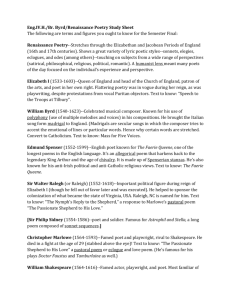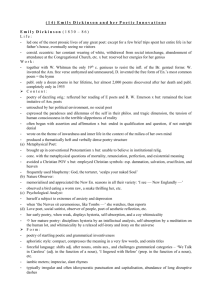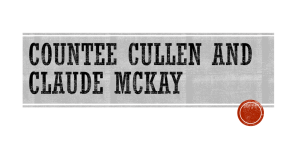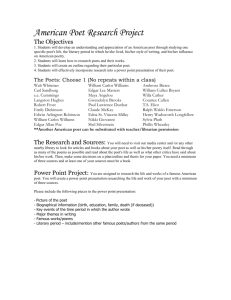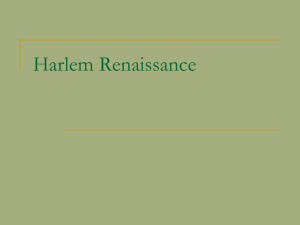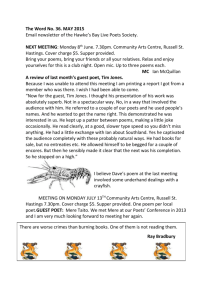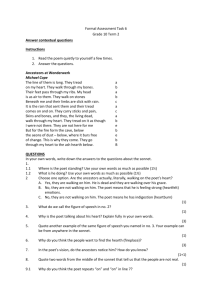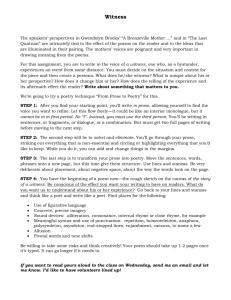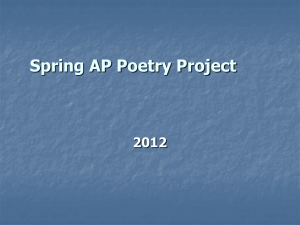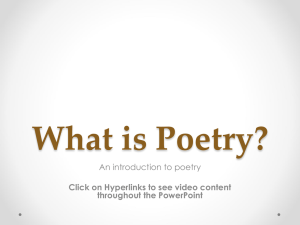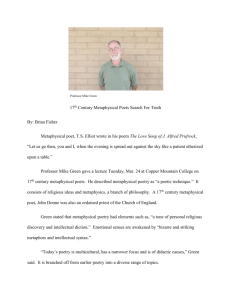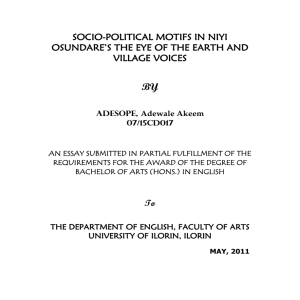Eng.IV.H. Renaissance Poets Brief Bios
advertisement
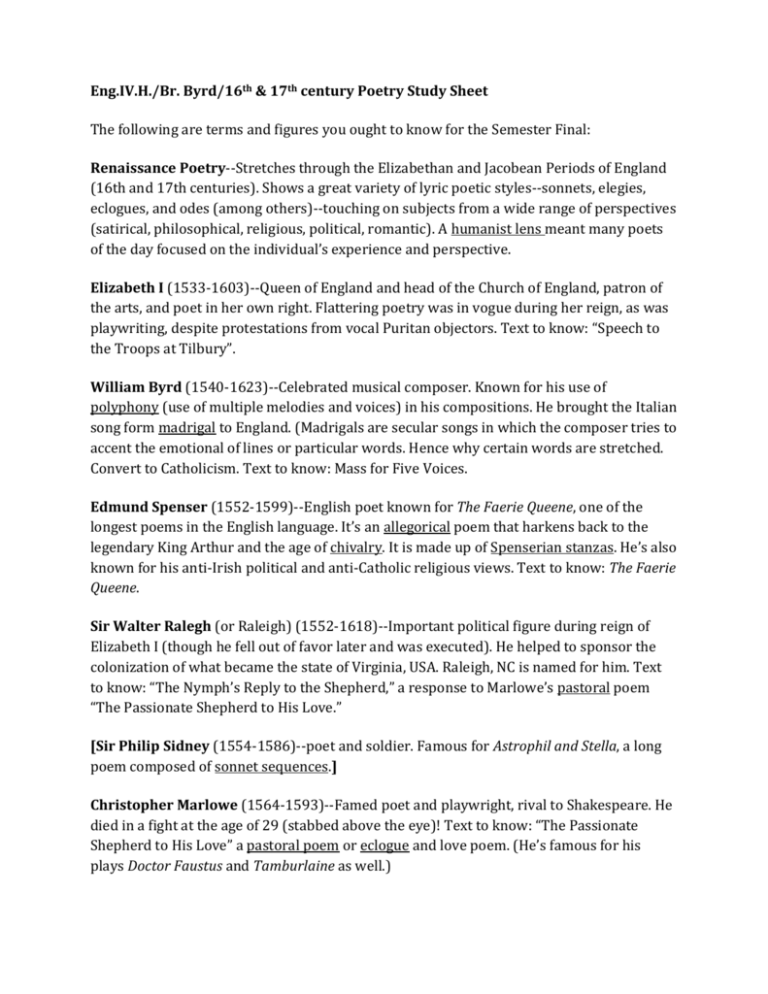
Eng.IV.H./Br. Byrd/16th & 17th century Poetry Study Sheet The following are terms and figures you ought to know for the Semester Final: Renaissance Poetry--Stretches through the Elizabethan and Jacobean Periods of England (16th and 17th centuries). Shows a great variety of lyric poetic styles--sonnets, elegies, eclogues, and odes (among others)--touching on subjects from a wide range of perspectives (satirical, philosophical, religious, political, romantic). A humanist lens meant many poets of the day focused on the individual’s experience and perspective. Elizabeth I (1533-1603)--Queen of England and head of the Church of England, patron of the arts, and poet in her own right. Flattering poetry was in vogue during her reign, as was playwriting, despite protestations from vocal Puritan objectors. Text to know: “Speech to the Troops at Tilbury”. William Byrd (1540-1623)--Celebrated musical composer. Known for his use of polyphony (use of multiple melodies and voices) in his compositions. He brought the Italian song form madrigal to England. (Madrigals are secular songs in which the composer tries to accent the emotional of lines or particular words. Hence why certain words are stretched. Convert to Catholicism. Text to know: Mass for Five Voices. Edmund Spenser (1552-1599)--English poet known for The Faerie Queene, one of the longest poems in the English language. It’s an allegorical poem that harkens back to the legendary King Arthur and the age of chivalry. It is made up of Spenserian stanzas. He’s also known for his anti-Irish political and anti-Catholic religious views. Text to know: The Faerie Queene. Sir Walter Ralegh (or Raleigh) (1552-1618)--Important political figure during reign of Elizabeth I (though he fell out of favor later and was executed). He helped to sponsor the colonization of what became the state of Virginia, USA. Raleigh, NC is named for him. Text to know: “The Nymph’s Reply to the Shepherd,” a response to Marlowe’s pastoral poem “The Passionate Shepherd to His Love.” [Sir Philip Sidney (1554-1586)--poet and soldier. Famous for Astrophil and Stella, a long poem composed of sonnet sequences.] Christopher Marlowe (1564-1593)--Famed poet and playwright, rival to Shakespeare. He died in a fight at the age of 29 (stabbed above the eye)! Text to know: “The Passionate Shepherd to His Love” a pastoral poem or eclogue and love poem. (He’s famous for his plays Doctor Faustus and Tamburlaine as well.) Eng.IV.H./Br. Byrd/16th & 17th century Poetry Study Sheet William Shakespeare (1564-1616)--Famed actor, playwright, and poet. Most familiar of all English writers. He often recycled and improved stories and plays that were already well known. He perfected the English sonnet (a popular Italian poetic form), writing love sonnets to both men and women. Texts to know: Macbeth, Hamlet, and “Sonnet 18” and “Sonnet 116.” John Donne (1572-1631)--Poet, lawyer, Anglican priest. Major metaphysical poet. Text to know: “The Flea,” “Holy Sonnet 10” and “Holy Sonnet 14.” Aemilia Lanyer (1569-1645)--First woman to declare herself a poet in England (meaning that she saw herself as a career poet, equal to the male poets of the day). She is often labelled a “proto-feminist”--a person whose views accord with the feminist movement of the 20th century well before that movement actually happened. Text to know: “Eve’s Apology in Defense of Women.” [Ben Jonson (1572-1637)--playwright, poet, and literary critic. Popularized the comedy of errors genre of drama. Considered in his day to be second only to Shakespeare.] Lady Mary Wroth (1587-1651)--One of the first females to achieve lasting literary fame. Relative to Sir Walter Ralegh and Sir Philip Sidney. Text to know: Pamphilia to Amphilanthus (a sonnet sequence from her scandalous novel Urania). Competed with Queen Anne of Denmark (Wife of James I) for George Herbert’s affections. George Herbert (1593-1633)--Welsh-born English poet and Anglican priest. Metaphysical poet. Text to know: “Love” and “The Pulley.” Robert Herrick (1591-1674)--Anglican priest and poet. Like Milton, Herrick’s life spans the Jacobean, Commonwealth, and Restoration Periods of England. Text to know: “To the Virgins to Make Much of Time.” Andrew Marvell (1621-1678)--poet of love lyrics, pastorals, and country-house poetry. Text to know: “To His Coy Mistress.” John Milton (1608-1674)--political activist and pamphleteer, poet. Career spans the end of the Jacobean Period, through the Commonwealth Period, to the early Restoration Period. Text to know: Paradise Lost. “Carpe Diem” Poetry--Poetry whose underlying theme is “seize the day,” aka “don’t waste time,” or, in biblical terms, “eat, drink, and be merry” (Ecclesiastes 8:15). These poems Eng.IV.H./Br. Byrd/16th & 17th century Poetry Study Sheet emphasize death as the ender of human joys, so the need to enjoy oneself now is urgent. Sex, food, drink, etc., are seen as important things. Contrast such poems with metaphysical poetry. Cavalier Poets--1637-1660, poetry by poets loyal to King Charles I against parliament. Focused on the concerns of the upper class before the execution of Charles I and the establishment of the English Commonwealth under Cromwell. Poems about the courtly themes of beauty, love, and loyalty. Inspired by Ben Jonson and John Donne. Text to know: Robert Herrick’s “To the Virgins to Make Much of Time.” Metaphysical Poetry--Poetry concerned with philosophical and religious matters as well as love and art and learning. It often deals with these in surprising language, unique metaphors, passionate voice. Emphasize paradox--the difficulty of understanding how components of life fit together. Examples: John Donne’s poetry, Andrew Marvell’s “To His Coy Mistress,” and George Herbert’s “Love” and “The Pulley,” and Sir Edward Dyer’s “My Mind to Me a Kingdom Is” (put to music by William Byrd). (If you think some poems can be categorized under multiple headings, that’s fine. Remember, poets don’t write with categories in mind. They write with or against the spirit of their times.) Country-House Poetry--Poetry which compliments a wealthy patron of the poetry through the lavish description of that patron’s country estate. Popular poetic genre during the 17th century in England. Famous examples: Ben Jonson’s “To Penshurst” and Marvell’s Upon Appleton House. House of Tudor: Henry VIII Edward VI Lady Jane Grey Mary I Elizabeth I House of Stuart: James I Charles I [Commonwealth/Protectorate (Oliver Cromwell, Richard Cromwell)] Charles II James II William III and Mary II Anne (last Stuart Monarch)
